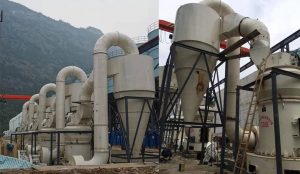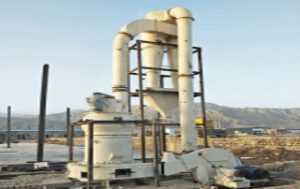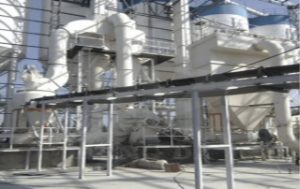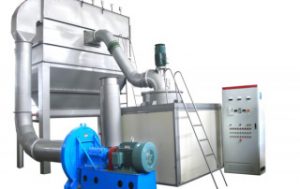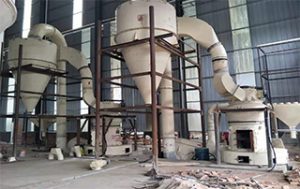Bentonite is a non-metallic mineral with montmorillonite as the main mineral component. The montmorillonite structure is a 2:1 crystal structure composed of two silica tetrahedrons sandwiched with a layer of alumina octahedron. Due to the layered structure formed by montmorillonite crystal cells, there are some cations, such as Cu, Mg, Na, K, etc., and the interaction between these cations and montmorillonite crystal cells is very unstable and easy to be exchanged by other cations, Therefore, it has good ion exchange. Abroad, it has been applied in more than 100 departments in 24 fields of industrial and agricultural production, and there are more than 300 products. Therefore, it is called “universal soil”.
Bentonite is also called porphyry rock, bentonite or bentonite rock. The development and use of bentonite in China has a long history. It was only used as a detergent. (there were open-pit mines in Renshou area of Sichuan hundreds of years ago, and the locals call bentonite powder). It has been widely used for only a hundred years. The earliest discovery in the United States was that in the ancient stratum of Wyoming, yellow green clay can expand into paste after adding water. Later, people collectively referred to all clays with this property as bentonite. In fact, the main mineral component of bentonite is montmorillonite, with a content of 85-90%. Some properties of bentonite are also determined by montmorillonite. Montmorillonite can be in various colors, such as yellow green, yellow white, gray, white and so on. It can be dense block or loose soil. It feels slippery when rubbing with your fingers. The volume of the small block expands several times to 20-30 times after adding water. It is suspended in water and pasty when there is little water. The properties of montmorillonite are related to its chemical composition and internal structure.
When the interlayer cation is Na +, it is called sodium bentonite; When the interlayer cation is Ca2 +, it is called calcium bentonite; When the interlayer cation is H +, it is called hydrogen bentonite (active clay, natural bleaching clay acid clay); When interlayer cations are organic cations, they are called organic bentonite.
Activated clay
Activated clay is an adsorbent made of clay (mainly bentonite) as raw material, inorganic acidification treatment, water rinsing and drying. Its appearance is milky white powder, odorless, tasteless and non-toxic. It has strong adsorption performance and can adsorb colored and organic substances. It is easy to absorb moisture in the air, and the adsorption performance will be reduced if it is placed too long. However, when heated to more than 300 ℃, the crystalline water begins to lose, which changes the structure and affects the fading effect. Active clay is insoluble in water, organic solvents and various oils, almost completely soluble in hot caustic soda and hydrochloric acid, with a relative density of 2.3 ~ 2.5, and very little bentonite in water and oil.
Natural bleaching soil
That is, the naturally produced white clay with bleaching property is a white and white gray clay with montmorillonite, albite and quartz as the main components. It is a kind of bentonite.
It is mainly the product of the decomposition of glassy volcanic rock. It does not expand after water absorption, and the pH value of the suspension is weakly acidic, which is different from alkaline bentonite; Its bleaching performance is worse than that of activated clay. The colors are generally light yellow, green white, gray, Xi Lan color, brown, milky white, peach, blue, etc. Few are pure white. Density: 2.7-2.9g/cm. The apparent density is often low due to porosity. The chemical composition is similar to that of ordinary clay. The main chemical composition is aluminum oxide, silicon dioxide, water and a small amount of iron, magnesium and calcium. No plasticity, high adsorption. Because it contains a large amount of aqueous silicic acid, it is acidic to litmus. The water is easy to crack and contains a lot of water. Generally, the finer the fineness, the higher the decolorizing power.
During the quality evaluation in the exploration stage, the bleaching performance, acidity, filtration performance, oil absorption and other items shall be measured [1]
Organic bentonite
Organic bentonite is a kind of inorganic mineral / organic ammonium complex, which is made from bentonite by inserting organic covering agent through ion exchange technology, using the layered structure of montmorillonite in bentonite and its characteristics of swelling and dispersing into colloidal clay particles in water or organic solvent. Organic bentonite can form gelatin in various organic solvents, Oils and liquid resins. It has good thickening, thixotropy, suspension stability, high temperature stability, lubricity, film-forming property, water resistance and chemical stability. It has important application value in coating industry. It is also widely used in paint and ink, aviation, metallurgy, chemical fiber, petroleum and other industries.
Bentonite ore
Bentonite ore is a multi-purpose mineral. Its quality and application field mainly depend on the content, attribute type and crystal chemical characteristics of montmorillonite. Therefore, its development and utilization must vary from mine to mine and from function to function. Such as the production of activated clay, calcium base to sodium base, drilling grouting for oil drilling, replacing starch for spinning, printing and dyeing slurry, internal and external wall coating on building materials, preparation of organic bentonite, synthesis of 4A zeolite with bentonite, production of silica, etc.
Difference between calcium and sodium
The interlayer cation type of bentonite determines the type of bentonite. When the interlayer cation is Na +, it is called sodium bentonite; When the interlayer cation is Ca +, it is called calcium bentonite. The properties of sodium montmorillonite (or sodium bentonite) are better than those of calcium. However, the distribution of calcareous soil in the world is much wider than that of sodium soil. Therefore, in addition to strengthening the search for sodium soil, it is necessary to modify the calcareous soil to make it become sodium soil. [2]
nature
sketch
Bentonite
Bentonite
Bentonite is a kind of clay rock, also known as montmorillonite clay rock, which often contains a small amount of illite, kaolinite, halloysite, chlorite, zeolite, quartz, feldspar, calcite, etc; Generally white, light yellow, light gray, light green, pink, maroon, brick red, gray black, etc. due to the change of iron content; Waxy, earthy or greasy luster; Some bentonite are as loose as clay, while others are dense and hard. The main chemical components are silicon dioxide, aluminum oxide and water, as well as iron, magnesium, calcium, sodium, potassium and other elements. The content of Na2O and Cao has a great impact on the physical and chemical properties and technological properties of bentonite. Montmorillonite belongs to monoclinic system, which is usually earthy block, white, and sometimes light red, light green and light yellow. The luster is dim. Hardness 1 ~ 2, density 2 ~ 3G / cm3. According to the type, content and interlayer charge of exchangeable cations of montmorillonite, bentonite can be divided into sodium bentonite (alkaline soil), calcium bentonite (alkaline soil) and natural bleaching soil (acid soil or acid clay). Calcium bentonite also includes calcium sodium base and calcium magnesium base. Bentonite has strong hygroscopicity and expansibility. It can adsorb 8 ~ 15 times the volume of water, and the volume expansion can reach several times to 30 times; It can disperse into gel and suspension in aqueous medium. This medium solution has certain viscosity, thixotropy and lubricity; Strong cation exchange capacity; It has certain adsorption capacity for various gases, liquids and organic substances, and the maximum adsorption capacity can be up to 5 times its own weight; Its mixture with water, mud or fine sand has plasticity and adhesion; Acid bleaching clay with surface activity (active clay, natural bleaching clay acid clay) can adsorb colored ions.
Adsorptivity
Adsorption is a natural phenomenon of all solid substances. The phenomenon that some molecules gather on the surface of bentonite is called the adsorption of bentonite. This adsorption has been widely used in industry. For example, drilling mud often uses the adsorption characteristics of bentonite minerals to adjust mud parameters for different purposes. For example, adding fluid loss reducer means that one end of high molecular polymer is adsorbed on the surface of bentonite particles and the other end is dissolved in water, resulting in an indirect relationship between bentonite particles and water molecules. It forms a bridging action, reduces the free water in the mud, changes the performance parameters of the mud, and achieves the purpose of reducing the filtration rate.
Bentonite adsorption can be divided into three types: physical adsorption, chemical adsorption and ion exchange adsorption.
l) Physical adsorption. Physical adsorption is produced by the intermolecular attraction between adsorbent and adsorbate, that is, we often say van der Waals force. Physical adsorption is a reversible adsorption process, and the adsorption rate and desorption rate are in dynamic equilibrium under certain conditions. The main reason for physical adsorption is that the surface molecules of bentonite have surface energy. Because bentonite is highly dispersed in water, the physical adsorption phenomenon is very obvious.
2) Chemisorption. Chemical adsorption is produced by the chemical bond force between adsorbent and adsorbate, and the chemical adsorption is generally irreversible. The application of chemical treatment agent in drilling mud is a typical example of chemical adsorption. For example, when iron chromium lignosulfonate is added to bentonite mud, chromium ions are integrated and adsorbed on the edge of bentonite crystal. This chemical adsorption is obviously more stable than physical adsorption. Therefore, the bentonite mud treated with iron chromium lignosulfonate has high temperature resistance and can be used as a high temperature resistant mud system for geothermal and ultra deep wells.
3) Ion exchange adsorption. Bentonite mineral crystals are generally negatively charged, so equivalent cations with opposite charges should be adsorbed on the surface of bentonite particles. The adsorbed cations can exchange with the cations in the solution, which is called ion exchange adsorption. The characteristics of ion exchange adsorption are: the same number of ions exchange with each other and isoelectric quantity exchange with each other. The reaction of ion exchange adsorption is reversible, and the rate of adsorption and desorption is affected by ion concentration, which conforms to the law of mass action.
The factors affecting the adsorption of bentonite minerals are:
1) Influence of bentonite type. The adsorption capacity of sodium bentonite is obviously stronger than that of other types of bentonite minerals such as calcium.
2) Effect of bentonite particle size on crushing particle size. According to the theory of solid adsorption, the adsorption capacity of crushed bentonite minerals is significantly improved. The finer the crushed minerals are, the stronger the adsorption is.
3) Effect of solution medium. According to the electric double layer theory, bentonite mineral crystals are negatively charged and will undergo ion exchange when forming an electric double layer. If the ion concentration in the solution is too high, it will compress the electric double layer of bentonite particles, inhibit the dispersion and diffusion of bentonite, and even make bentonite agglomerate and coalesce.
Expansibility
Bentonite expands when it meets water. The main reason for this natural phenomenon is that the crystal layer spacing of bentonite minerals is increased, and water molecules enter the crystal layer of minerals. In addition, the reason for bentonite expansion is the cation exchange of bentonite minerals. The expansibility has a great relationship with the properties of bentonite and montmorillonite content. The expansibility of sodium bentonite is obviously stronger than that of calcium bentonite. In addition, the expansibility of bentonite with high purity and high montmorillonite content is stronger. Therefore, in practical application, if we mainly want to make use of the expansibility of bentonite minerals, we should first select sodium bentonite minerals and then consider sodium bentonite with high montmorillonite content when considering the types of bentonite minerals. In mechanical casting and iron ore pelletizing, the requirements for expansibility are high. A large amount of calcareous bentonite can not meet the use requirements, so it is necessary to modify the calcareous bentonite before use.
The dispersion degree of sodium bentonite is higher than that of calcium bentonite, and sodium bentonite has high water absorption and large expansion multiple. The reasons for the different results of water absorption and expansion on sodium bentonite and calcium bentonite are as follows:
1) Cations can bind bentonite particles together, which restricts the dispersion of bentonite particles. The charge density of multivalent ions is higher than that of monovalent ions, and strong electrostatic attraction is generated between particles, which makes the connection ability of bentonite particles strong. Therefore, the dispersion ability of calcium bentonite is weaker than that of sodium bentonite.
2) The negative charge produced by lattice replacement of montmorillonite needs to adsorb ions with opposite electricity to balance the electricity of the solution. These ions with opposite electrical properties exist in the solution in the form of hydrated ions. Negatively charged montmorillonite particles adsorb hydrated cations to form an electric double layer. The thickness of the electric double layer is inversely proportional to the second power of the counter ion valence, that is, the cation valence is high, the hydration film is thin and the expansion multiple is low; The cationic valence effect is low, the hydration film is thick and the expansion ratio is high.
3) The thickness of water adsorbed by sodium bentonite crystal layer is three layers, and the thickness of water adsorbed by calcium bentonite crystal layer is four layers. Under the action of polar water molecules, due to the small electrostatic attraction, large crystal layer spacing can be generated between the crystal layers of sodium bentonite, while the polar water molecules are not easy to enter between the crystal layers of calcium bentonite due to the large electrostatic attraction between the crystal layers. Therefore, the distance between the crystal layers of calcium bentonite is obviously smaller than that of sodium bentonite, Calcium bentonite is more difficult to disperse in water and has lower expansion ratio than sodium bentonite. In essence, the swelling property of montmorillonite is controlled by its chemical composition. Montmorillonite containing more sodium ions can expand continuously until it becomes a gel state. Montmorillonite containing more calcium ions can only expand from dry operation state to water state, which is limited. After understanding the deep-seated reasons affecting the swelling of bentonite, we can artificially and effectively control the swelling performance of bentonite minerals to achieve the best use effect.
Pulping Property
The slurry making rate is that the bentonite particles are dispersed in water to form a suspension, and when the apparent viscosity of this suspension is 15 * 10-3ps · s, the number of cubic meters of slurry making per ton of bentonite is an important index to measure the quality of bentonite. Generally, the slurry making performance of sodium bentonite is better than that of calcium bentonite. The formula for calculating the slurry selection rate is:
Paddle making rate (m3 / T) = volume of water (ML) / mass of soil (g) + 1 / density of soil. Generally, the apparent viscosity is 10 ~ 25 when testing the apparent viscosity Three cups of slurry within the range of (* 10-3 PA · s), after stirring and standing still for 16h, mix and test the viscosity, then mark the positions of the three points on the single logarithmic coordinate paper, connect the lines, and calculate the amount of soil added when the apparent viscosity is 15 * 10-3 PA · s on the coordinates.
application
The properties of montmorillonite are closely related to the types of interlayer exchangeable cations. According to the types of interlayer main exchangeable cations, montmorillonite is usually divided into calcium montmorillonite and sodium montmorillonite.
Montmorillonite has adsorption and cation exchange properties, and can be used for removing toxins from edible oil, purification of gasoline and kerosene, and wastewater treatment; due to its good water absorption and expansion properties, dispersion, suspension and slurry making properties, montmorillonite is used for drilling mud and flame retardant (suspension fire extinguishing) It can also be used as a filler in the paper industry to optimize the performance of the coating, such as adhesion, covering power, water resistance, washing resistance, etc.; due to its good adhesion, it can be used instead of starch for yarn sizing in the textile industry, which can not only save grain, but also do not hair, and there is no peculiar smell after the paddle, which is really double benefit with one stroke.
Generally speaking, the properties of sodium montmorillonite (or sodium bentonite) are better than those of calcium.
Bentonite (montmorillonite) has good physical and chemical properties. It can be used as purification decolorizer, binder, thixotropic agent, suspending agent, stabilizer, filler, feed, catalyst, etc. it is widely used in agriculture, light industry, cosmetics, drugs and other fields. Therefore, montmorillonite is a natural mineral material with a wide range of uses.
Bentonite can be used as waterproof materials, such as bentonite waterproof blanket, bentonite waterproof board and its supporting materials, which are laid by mechanical fixation method. It is applied to the underground environment with pH value of 4 to 10. The modified bentonite shall be used in the environment with high salt content, and shall be used after passing the test.
Bentonite grinding process flow
Stage I: crushing
The bulk bentonite material is crushed by the crusher to the feed fineness (less than 30mm) that can enter the pulverizer.
Stage 2: material grinding
The crushed bentonite small materials are sent to the raw material bin through the elevator, and then sent to the grinding chamber of the mill evenly and quantitatively through the vibrating feeder for grinding. After grinding, the milled materials are graded by the analyzer. Those whose fineness meets the specification flow into the large cyclone collector with the wind, and then discharged into finished products through the discharge valve. Those whose fineness is unqualified cannot be screened by the analyzer, but still fall back to the host for re grinding.
Stage III: storage or packaging of finished products in cans
① The finished products discharged from the discharge valve are transported to the finished product tank for storage by pneumatic conveying equipment.
② The finished products discharged from the discharge valve are packaged by a double mouth packaging machine.
③ The finished products discharged from the discharge valve are packaged by the ton baler.


